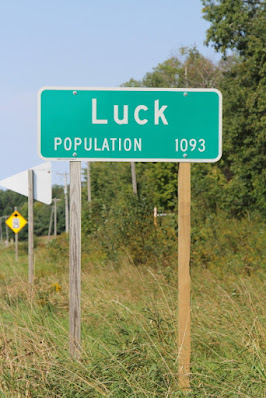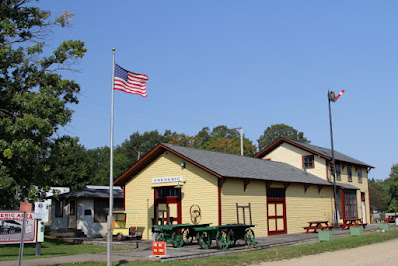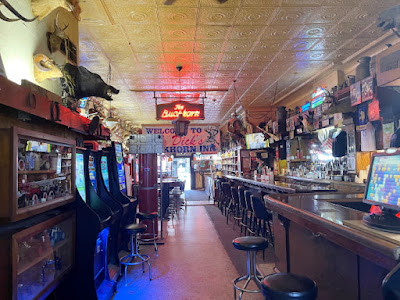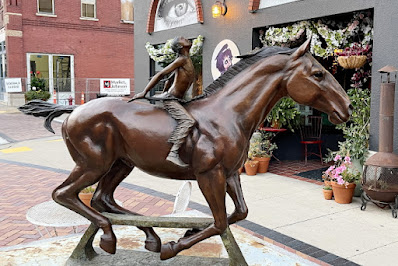Chippewa County, Wisconsin, is so concerned about keeping their county clean, they even put up signs "Stop Poo." (GPS Coordinates: 44.886344 -91.388920)
Cornell (population 1,467) is located along Highway 27 where it crosses the Chippewa River. The city was named for Ezra Cornell, one of the founders of Western Union, who was also a large land owner in the area. Upon his death, his estate became part of an endowment for Cornell University in Ithaca, New York.
Adjacent to the river is the only surviving pulpwood stacker in the United States. It was built in 1911, to stack large quantities of pulpwood logs until they could be processed in the nearby papermill. The pictures do not accurately represent the size of the stacker. This thing is enormous! It dwarfs the nearby trees and building. I do not know what the wooden statue located at the base of the stacker represents because there was not a placard describing the art work.
Indian Mounds Park is located along the western shore of Rice Lake, which is in the city of Rice Lake. Originally, there were over fifty mounds at this location, but the Smithsonian Institution excavated many of them in the early 1900s, and then in the 1950s other were excavated by different groups. Some mounds were also destroyed by developers, so currently there are only 12 unexcavated mounds around the lake. It is believed that the Rice Lake mounds were build in about 500 A.D. and they are some of the northernmost mounds ever discovered.
Cumberland (population 2,170) is unique because it is known as "The Island City" and not located near an ocean. The main part of the city is located on an island in Beaver Dam Lake.
Luck (population 1,119) was originally two settlements that were close together but knew it was impractical to remain separate entities. The residents disagreed on which settlement would be the center of town, so the railroad settled the dispute when they laid their track next to the eastern settlement and the town's name became "Luck." At one time, Luck was the headquarters for the Duncan Toys Company Yo-Yo factory.
Frederic (population 1,137) is know as "The village named after a boy." In the late 1800s William Star purchased 12,00 acres of land from the Cushing Land Agency, who had purchased 50,000 acres of land from the US Government for $1.25 per acre. He persuaded the Soo Line Railroad to extend their rail line to his property and then constructed a sawmill that employed over 200 men. A town was started and soon there was a newspaper, physician, two hotel, school, and 18 retail businesses. He named the town "Frederic," after his son.
The Frederic Area Historical Museum is now located in the historic railroad depot and there are several other historical buildings on the site. After the rails were removed, the railroad rights-of-way were converted into the Candy Dancer State Trail that is very popular with hikers, bicyclists, and snowmobilers. On a historical plaque by the depot it states: "The past should always remain a part of our future." I really like that quote.
In the 1880s, Swedish immigrants started settling in the area that is now Siren (population 806) and by 1895 there were enough residents to apply for a post office. Since there was no postal building, the Swedes used Charles F. Segerstrom's house as the post office. Segerstrom's house was completely surrounded by lilacs, so on the postal application they listed the town's name as "Syren," which is Swedish for "lilac." The Postal Department assumed "Syren" was a misspelling and named the town "Siren." There is a nice veterans park in Siren.
Anyone driving through the northwest part of Wisconsin has probably passed through Spooner (population 2,573). Spooner is known as the "Crossroads of the North," which is a reference to the junctions of US Highways 53 and 63, and State Highways 70 and 253.
Spooner is also known as the Hub of the "Great Omaha X" Railroad. During its heyday, passing through Spooner every day there were 18 passenger trains, 11 logging trains, 10 freight trains, 4 section crews, and 55 chain gang crews. On a reduced scale, Spooner continues to be an important railroad center.
The Division Headquarters were located in Spooner with a large passenger depot, freight depot, express office, restaurant, switching yards, roundhouse, locomotive and car shops, lumberyards, and division office. The division office employed 600 people including the superintendent, trainmasters, dispatchers, master mechanics, road masters, bridge and building supervisors, freight agents, engineers, firemen, conductors, brakemen, switchmen, repairmen, baggagemen, and office workers.
Nowadays, a popular stopping spot in Spooner is Big Dick's Buckhorn Inn. Walls in the bar are completely covered with taxidermy mounts of animals, fish and other unusual items; but the main attraction is the men's restroom. Apparently, on March 18, 1960, President John F. Kennedy was passing through Spooner and needed to use the men's restroom, so he visited Big Dick's Buckhorn Inn. There is now a plaque on the men's restroom door commemorating his visit.
On the outskirts of Spooner there is a good guy wearing a white hat watching over things to keep peace in the community.






















































































